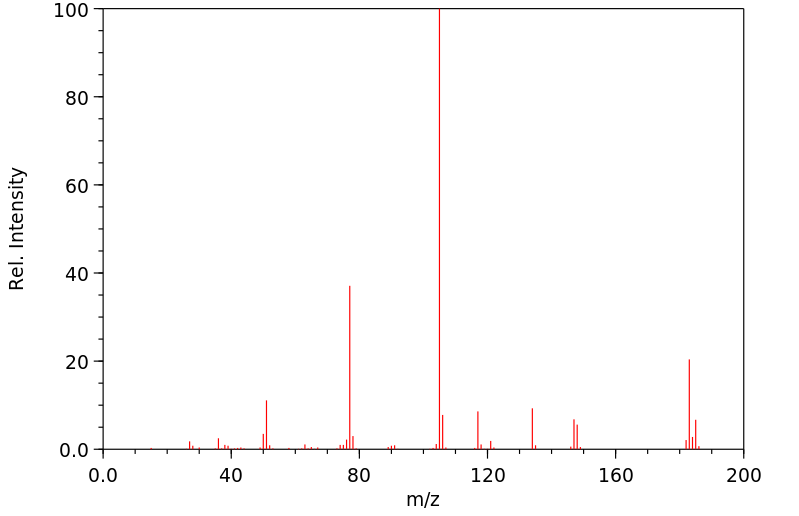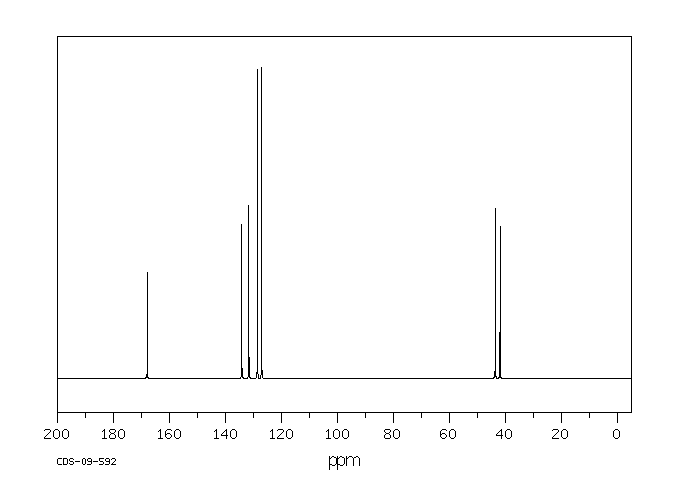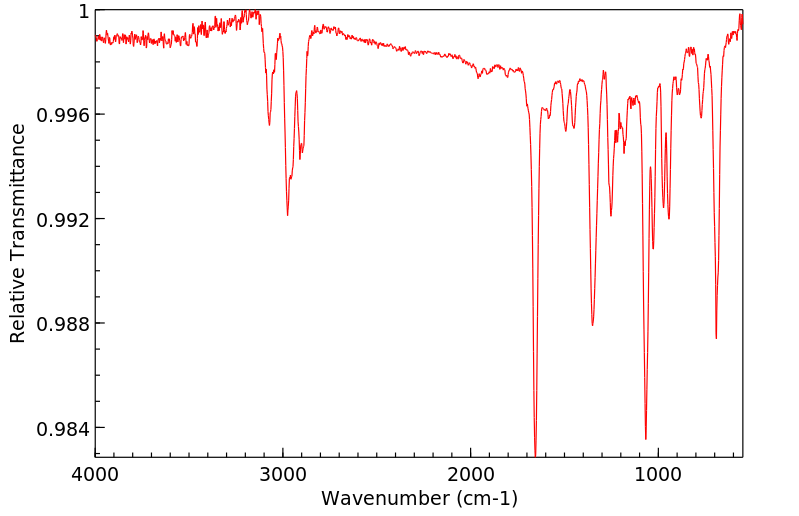N-(2-氯乙基)苯甲酰胺 | 26385-07-9
中文名称
N-(2-氯乙基)苯甲酰胺
中文别名
N-(4-氯乙基)乙酰胺;N-(2-氯乙基)乙酰胺
英文名称
N-(2-chloro-ethyl)-benzamide
英文别名
N-(2-Chlor-ethyl)benzamid;2-(benzoylamino)-1-chloroethane;N-Benzoyl-β-chlor-ethylamin;2-benzoylaminoethyl chloride;N-(2-Chloroethyl)benzamide
CAS
26385-07-9
化学式
C9H10ClNO
mdl
——
分子量
183.637
InChiKey
FYQJUYCGPLFWQR-UHFFFAOYSA-N
BEILSTEIN
——
EINECS
——
-
物化性质
-
计算性质
-
ADMET
-
安全信息
-
SDS
-
制备方法与用途
-
上下游信息
-
文献信息
-
表征谱图
-
同类化合物
-
相关功能分类
-
相关结构分类
物化性质
-
熔点:103-106 °C(lit.)
-
沸点:366.4±25.0 °C(Predicted)
-
密度:1.1611 (rough estimate)
-
稳定性/保质期:
如果遵照规格使用和储存,则不会分解。避免接触氧化物。
计算性质
-
辛醇/水分配系数(LogP):1.6
-
重原子数:12
-
可旋转键数:3
-
环数:1.0
-
sp3杂化的碳原子比例:0.22
-
拓扑面积:29.1
-
氢给体数:1
-
氢受体数:1
安全信息
-
安全说明:S26,S36
-
危险类别码:R36/37/38
-
WGK Germany:3
-
海关编码:2924299090
-
储存条件:将贮藏器密封后,放入一个紧密的容器中,并将其存放在阴凉、干燥的地方。
SDS
| Name: | N-(2-Chloroethyl)benzamide 99% Material Safety Data Sheet |
| Synonym: | None known |
| CAS: | 26385-07-9 |
Synonym:None known
Section 2 - COMPOSITION, INFORMATION ON INGREDIENTS
| CAS# | Chemical Name | content | EINECS# |
| 26385-07-9 | N-(2-Chloroethyl)benzamide | 99 | 247-641-4 |
Risk Phrases: None Listed.
Section 3 - HAZARDS IDENTIFICATION
EMERGENCY OVERVIEW
The toxicological properties of this material have not been fully investigated.
Potential Health Effects
Eye:
May cause eye irritation.
Skin:
May cause skin irritation.
Ingestion:
May cause irritation of the digestive tract. The toxicological properties of this substance have not been fully investigated.
Inhalation:
May cause respiratory tract irritation. The toxicological properties of this substance have not been fully investigated.
Chronic:
No information found.
Section 4 - FIRST AID MEASURES
Eyes: Flush eyes with plenty of water for at least 15 minutes, occasionally lifting the upper and lower eyelids. Get medical aid.
Skin:
Get medical aid. Flush skin with plenty of water for at least 15 minutes while removing contaminated clothing and shoes. Wash clothing before reuse.
Ingestion:
Never give anything by mouth to an unconscious person. Get medical aid. Do NOT induce vomiting. If conscious and alert, rinse mouth and drink 2-4 cupfuls of milk or water.
Inhalation:
Remove from exposure and move to fresh air immediately. If not breathing, give artificial respiration. If breathing is difficult, give oxygen. Get medical aid.
Notes to Physician:
Section 5 - FIRE FIGHTING MEASURES
General Information:
As in any fire, wear a self-contained breathing apparatus in pressure-demand, MSHA/NIOSH (approved or equivalent), and full protective gear. During a fire, irritating and highly toxic gases may be generated by thermal decomposition or combustion.
Extinguishing Media:
Use agent most appropriate to extinguish fire. Use water spray, dry chemical, carbon dioxide, or appropriate foam.
Section 6 - ACCIDENTAL RELEASE MEASURES
General Information: Use proper personal protective equipment as indicated in Section 8.
Spills/Leaks:
Vacuum or sweep up material and place into a suitable disposal container. Clean up spills immediately, observing precautions in the Protective Equipment section. Avoid generating dusty conditions.
Provide ventilation.
Section 7 - HANDLING and STORAGE
Handling:
Wash thoroughly after handling. Remove contaminated clothing and wash before reuse. Use with adequate ventilation. Minimize dust generation and accumulation. Avoid contact with eyes, skin, and clothing. Keep container tightly closed. Avoid ingestion and inhalation.
Storage:
Store in a tightly closed container. Store in a cool, dry, well-ventilated area away from incompatible substances.
Section 8 - EXPOSURE CONTROLS, PERSONAL PROTECTION
Engineering Controls:
Facilities storing or utilizing this material should be equipped with an eyewash facility and a safety shower. Use adequate ventilation to keep airborne concentrations low.
Exposure Limits CAS# 26385-07-9: Personal Protective Equipment Eyes: Wear appropriate protective eyeglasses or chemical safety goggles as described by OSHA's eye and face protection regulations in 29 CFR 1910.133 or European Standard EN166.
Skin:
Wear appropriate protective gloves to prevent skin exposure.
Clothing:
Wear appropriate protective clothing to prevent skin exposure.
Respirators:
A respiratory protection program that meets OSHA's 29 CFR 1910.134 and ANSI Z88.2 requirements or European Standard EN 149 must be followed whenever workplace conditions warrant respirator use.
Section 9 - PHYSICAL AND CHEMICAL PROPERTIES
Physical State: Powder
Color: beige
Odor: none reported
pH: Not available.
Vapor Pressure: Not available.
Viscosity: Not available.
Boiling Point: Not available.
Freezing/Melting Point: 103.00 - 106.00 deg C
Autoignition Temperature: Not applicable.
Flash Point: Not applicable.
Explosion Limits, lower: Not available.
Explosion Limits, upper: Not available.
Decomposition Temperature:
Solubility in water:
Specific Gravity/Density:
Molecular Formula: C9H10ClNO
Molecular Weight: 183.64
Section 10 - STABILITY AND REACTIVITY
Chemical Stability:
Stable under normal temperatures and pressures.
Conditions to Avoid:
Incompatible materials, dust generation, excess heat, strong oxidants.
Incompatibilities with Other Materials:
Oxidizing agents.
Hazardous Decomposition Products:
Hydrogen chloride, nitrogen oxides, carbon monoxide, irritating and toxic fumes and gases, carbon dioxide.
Hazardous Polymerization: Has not been reported
Section 11 - TOXICOLOGICAL INFORMATION
RTECS#:
CAS# 26385-07-9 unlisted.
LD50/LC50:
Not available.
Carcinogenicity:
N-(2-Chloroethyl)benzamide - Not listed by ACGIH, IARC, or NTP.
Section 12 - ECOLOGICAL INFORMATION
Section 13 - DISPOSAL CONSIDERATIONS
Dispose of in a manner consistent with federal, state, and local regulations.
Section 14 - TRANSPORT INFORMATION
IATA
Not regulated as a hazardous material.
IMO
Not regulated as a hazardous material.
RID/ADR
Not regulated as a hazardous material.
Section 15 - REGULATORY INFORMATION
European/International Regulations
European Labeling in Accordance with EC Directives
Hazard Symbols: Not available.
Risk Phrases:
Safety Phrases:
S 24/25 Avoid contact with skin and eyes.
S 28A After contact with skin, wash immediately with
plenty of water.
S 37 Wear suitable gloves.
S 45 In case of accident or if you feel unwell, seek
medical advice immediately (show the label where
possible).
WGK (Water Danger/Protection)
CAS# 26385-07-9: No information available.
Canada
None of the chemicals in this product are listed on the DSL/NDSL list.
CAS# 26385-07-9 is not listed on Canada's Ingredient Disclosure List.
US FEDERAL
TSCA
CAS# 26385-07-9 is not listed on the TSCA inventory.
It is for research and development use only.
SECTION 16 - ADDITIONAL INFORMATION
N/A
上下游信息
-
上游原料
中文名称 英文名称 CAS号 化学式 分子量 —— N-(2-hydroxyethyl)-benzamide 16405-21-3 C9H11NO2 165.192 1-苯甲酰基氮丙啶 N-benzoylaziridine 7646-66-4 C9H9NO 147.177 -
下游产品
中文名称 英文名称 CAS号 化学式 分子量 N-乙苯甲醯胺 N-ethylbenzamide 614-17-5 C9H11NO 149.192 —— N-(2-hydroxyethyl)-benzamide 16405-21-3 C9H11NO2 165.192 —— N-(2-iodo-ethyl)-benzamide 15257-86-0 C9H10INO 275.089 —— N-(<2-D1>ethyl)benzamide 100938-82-7 C9H11NO 150.184 —— N-(2-methylthioethyl)benzamide 60116-82-7 C10H13NOS 195.285 —— N-(2-azidoethyl)benzamide 72200-26-1 C9H10N4O 190.205 —— N,N'-dibenzoylselenocystamine 6474-42-6 C18H20N2O2Se2 454.289 N-苯甲酰基-beta-丙氨酸 N-benzoyl-beta-alanine 3440-28-6 C10H11NO3 193.202 N-苯乙基苯甲酰胺 N-phenethylbenzamide 3278-14-6 C15H15NO 225.29 —— N-[(3E)-3-octenyl]benzamide 144765-56-0 C15H21NO 231.338 N-[2-(4-甲基苯基)乙基]苯甲酰胺 N-(4-methylphenethyl)benzamide 3278-15-7 C16H17NO 239.317 —— 1,4-Bis(2-benzamidoethyl)benzene 150933-07-6 C24H24N2O2 372.467 —— N-(3-hydroxy-3-methylbutyl)benzamide 34021-60-8 C12H17NO2 207.272 N-(3-羟基-4-甲基戊基)苯甲酰胺 N-(3-hydroxy-4-methylpentyl)benzamide 118089-81-9 C13H19NO2 221.299 —— (E)-N-(4-phenylbut-3-en-1-yl)benzamide 7651-77-6 C17H17NO 251.328 —— N-(4-bromophenethyl)benzamide 3185-50-0 C15H14BrNO 304.186 N-[2-(4-氨基苯基)乙基]苯甲酰胺 N-(4-aminophenethyl)benzamide 144765-53-7 C15H16N2O 240.305 —— trans-ethyl-<(N-benzoyl)-5-amino>pent-2-enoate —— C14H17NO3 247.294 —— 2-benzamidoethyl benzoate 16180-99-7 C16H15NO3 269.3 N-[2-(4-甲氧基苯基)乙基]苯甲酰胺 N-[2-(4-methoxyphenyl)ethyl]benzamide 3278-19-1 C16H17NO2 255.316 —— N-(2-pyridin-3-yl-ethyl)-benzamide 107776-87-4 C14H14N2O 226.278 —— N-(2-{[Tris(dimethylamino)-lambda~5~-phosphanylidene]amino}ethyl)benzamide 72200-31-8 C15H28N5OP 325.394 - 1
- 2
- 3
反应信息
-
作为反应物:描述:N-(2-氯乙基)苯甲酰胺 在 正丁基锂 、 水 、 naphthalen-1-yl-lithium 作用下, 以 四氢呋喃 、 乙醚 为溶剂, 反应 4.0h, 生成 N-苯甲酰基-beta-丙氨酸参考文献:名称:N-锂乙基-N-(2-锂乙基)- 和 N-锂-N-(3-锂丙基)-苯甲酰胺:2-锂乙基-和 3-锂丙基胺当量的直接制备和合成应用摘要:2-氯乙基和 3-氯丙基苯甲酰胺与 N-丁基锂和萘化锂在 -78°C 至 -50°C 的温度范围内连续反应,产生 N-锂基-N-(2-锂乙基)- 和 N-锂基-N-(3-锂基-丙基)苯甲酰胺 [(8), (9)],通过用不同的亲电试剂(H2O、D2O、Me2S2、CO2、Pr1CHO、PhCHO、Me2CO、Ph2CO 和 O2)处理得到预期的官能化苯甲酰胺 [(10), 化合物 (10) 和 (11) 的酸性和碱性水解根据底物的结构和反应条件得出不同的结果。DOI:10.1016/s0040-4020(01)80078-8
-
作为产物:描述:参考文献:名称:388.硫化氢的添加到2-苯基Δ 2 -恶唑啉和benzoylethyleneimine:稠合的噻唑烷环butyroazlactone系统的尝试合成摘要:DOI:10.1039/jr9480001919
文献信息
-
One-pot triflic anhydride-mediated synthesis of 1,2-disubstituted 2-imidazolines from N-(2-haloethyl)amides and amines作者:Alyssa A. Ellsworth、Christina L. Magyar、Grace E. Hubbell、Chelsea C. Theisen、Daniel Holmes、R. Adam MoseyDOI:10.1016/j.tet.2016.08.040日期:2016.10A one-pot synthesis of 1,2-disubstituted 2-imidazolines from N-(2-haloethyl)amides has been developed. The reaction affords high yields of diverse 1,2-disubstituted 2-imidazolines from triflic anhydride-mediated dehydration of amides followed by installation of a primary amine.
-
Pyrimidinedione derivatives and antiarrhythmic agents containing same申请人:Mitsui Toatsu Chemicals, Incorporated公开号:US05332739A1公开(公告)日:1994-07-26Pyrimidinedione derivatives of the formula: ##STR1## wherein R.sup.1 and R.sup.2 is so linked with each other as to make an alkylene chain and thus form a heterocyclic structure, A, R.sup.3, R.sup.4, X.sup.1, X.sup.2 and X.sup.3 are substituents, respectively, and n is 2 or 3 have a basic backbone in which a phenyl group part and a pyrimidinedione part are linked by a structure comprising an alkyl chain and a heterocyclic ring having two nitrogen atoms. These compounds are useful for a medical treatment of cardiac arrhythmias.
-
Formamides as Lewis Base Catalysts in S<sub>N</sub>Reactions-Efficient Transformation of Alcohols into Chlorides, Amines, and Ethers作者:Peter H. Huy、Sebastian Motsch、Sarah M. KapplerDOI:10.1002/anie.201604921日期:2016.8.16and waste‐balance (E‐factor down to 2). Chiral substrates are converted with excellent levels of stereochemical inversion (99 %→≥95 % ee). In a practical one‐pot procedure, the primary formed chlorides can be further transformed into amines, azides, ethers, sulfides, and nitriles. The value of the method was demonstrated in straightforward syntheses of the drugs rac‐Clopidogrel and S‐Fendiline.
-
[EN] METHOD OF CONVERTING ALCOHOL TO HALIDE<br/>[FR] PROCÉDÉ DE CONVERSION D'UN ALCOOL EN HALOGÉNURE申请人:UNIV SAARLAND公开号:WO2016202894A1公开(公告)日:2016-12-22The present invention relates to a method of converting an alcohol into a corresponding halide. This method comprises reacting the alcohol with an optionally substituted aromatic carboxylic acid halide in presence of an N-substituted formamide to replace a hydroxyl group of the alcohol by a halogen atom. The present invention also relates to a method of converting an alcohol into a corresponding substitution product. The second method comprises: (a) performing the method of the invention of converting an alcohol into the corresponding halide; and (b) reacting the corresponding halide with a nucleophile to convert the halide into the nucleophilic substitution product.本发明涉及一种将醇转化为相应卤化物的方法。该方法包括在N-取代甲酰胺的存在下,将醇与可选择取代的芳香羧酸卤化物反应,以通过卤原子取代醇的羟基。本发明还涉及一种将醇转化为相应取代产物的方法。第二种方法包括:(a)执行将醇转化为相应卤化物的本发明方法;以及(b)将相应卤化物与亲核试剂反应,将卤化物转化为亲核取代产物。
-
Catalytic Phosphorus(V)-Mediated Nucleophilic Substitution Reactions: Development of a Catalytic Appel Reaction作者:Ross M. Denton、Jie An、Beatrice Adeniran、Alexander J. Blake、William Lewis、Andrew M. PoultonDOI:10.1021/jo201085r日期:2011.8.19from stoichiometric waste products into catalysts and a new concept for catalytic phosphorus-based activation and nucleophilic substitution of alcohols has been validated. The present study has focused on a full exploration of the scope and limitations of phosphine oxide catalyzed chlorination reactions as well as the development of the analogous bromination reactions. Further mechanistic studies, including
表征谱图
-
氢谱1HNMR
-
质谱MS
-
碳谱13CNMR
-
红外IR
-
拉曼Raman
-
峰位数据
-
峰位匹配
-
表征信息
同类化合物
(βS)-β-氨基-4-(4-羟基苯氧基)-3,5-二碘苯甲丙醇
(S,S)-邻甲苯基-DIPAMP
(S)-(-)-7'-〔4(S)-(苄基)恶唑-2-基]-7-二(3,5-二-叔丁基苯基)膦基-2,2',3,3'-四氢-1,1-螺二氢茚
(S)-盐酸沙丁胺醇
(S)-3-(叔丁基)-4-(2,6-二甲氧基苯基)-2,3-二氢苯并[d][1,3]氧磷杂环戊二烯
(S)-2,2'-双[双(3,5-三氟甲基苯基)膦基]-4,4',6,6'-四甲氧基联苯
(S)-1-[3,5-双(三氟甲基)苯基]-3-[1-(二甲基氨基)-3-甲基丁烷-2-基]硫脲
(R)富马酸托特罗定
(R)-(-)-盐酸尼古地平
(R)-(-)-4,12-双(二苯基膦基)[2.2]对环芳烷(1,5环辛二烯)铑(I)四氟硼酸盐
(R)-(+)-7-双(3,5-二叔丁基苯基)膦基7''-[((6-甲基吡啶-2-基甲基)氨基]-2,2'',3,3''-四氢-1,1''-螺双茚满
(R)-(+)-7-双(3,5-二叔丁基苯基)膦基7''-[(4-叔丁基吡啶-2-基甲基)氨基]-2,2'',3,3''-四氢-1,1''-螺双茚满
(R)-(+)-7-双(3,5-二叔丁基苯基)膦基7''-[(3-甲基吡啶-2-基甲基)氨基]-2,2'',3,3''-四氢-1,1''-螺双茚满
(R)-(+)-4,7-双(3,5-二-叔丁基苯基)膦基-7“-[(吡啶-2-基甲基)氨基]-2,2”,3,3'-四氢1,1'-螺二茚满
(R)-3-(叔丁基)-4-(2,6-二苯氧基苯基)-2,3-二氢苯并[d][1,3]氧杂磷杂环戊烯
(R)-2-[((二苯基膦基)甲基]吡咯烷
(R)-1-[3,5-双(三氟甲基)苯基]-3-[1-(二甲基氨基)-3-甲基丁烷-2-基]硫脲
(N-(4-甲氧基苯基)-N-甲基-3-(1-哌啶基)丙-2-烯酰胺)
(5-溴-2-羟基苯基)-4-氯苯甲酮
(5-溴-2-氯苯基)(4-羟基苯基)甲酮
(5-氧代-3-苯基-2,5-二氢-1,2,3,4-oxatriazol-3-鎓)
(4S,5R)-4-甲基-5-苯基-1,2,3-氧代噻唑烷-2,2-二氧化物-3-羧酸叔丁酯
(4S,4''S)-2,2''-亚环戊基双[4,5-二氢-4-(苯甲基)恶唑]
(4-溴苯基)-[2-氟-4-[6-[甲基(丙-2-烯基)氨基]己氧基]苯基]甲酮
(4-丁氧基苯甲基)三苯基溴化磷
(3aR,8aR)-(-)-4,4,8,8-四(3,5-二甲基苯基)四氢-2,2-二甲基-6-苯基-1,3-二氧戊环[4,5-e]二恶唑磷
(3aR,6aS)-5-氧代六氢环戊基[c]吡咯-2(1H)-羧酸酯
(2Z)-3-[[(4-氯苯基)氨基]-2-氰基丙烯酸乙酯
(2S,3S,5S)-5-(叔丁氧基甲酰氨基)-2-(N-5-噻唑基-甲氧羰基)氨基-1,6-二苯基-3-羟基己烷
(2S,2''S,3S,3''S)-3,3''-二叔丁基-4,4''-双(2,6-二甲氧基苯基)-2,2'',3,3''-四氢-2,2''-联苯并[d][1,3]氧杂磷杂戊环
(2S)-(-)-2-{[[[[3,5-双(氟代甲基)苯基]氨基]硫代甲基]氨基}-N-(二苯基甲基)-N,3,3-三甲基丁酰胺
(2S)-2-[[[[[((1S,2S)-2-氨基环己基]氨基]硫代甲基]氨基]-N-(二苯甲基)-N,3,3-三甲基丁酰胺
(2S)-2-[[[[[[((1R,2R)-2-氨基环己基]氨基]硫代甲基]氨基]-N-(二苯甲基)-N,3,3-三甲基丁酰胺
(2-硝基苯基)磷酸三酰胺
(2,6-二氯苯基)乙酰氯
(2,3-二甲氧基-5-甲基苯基)硼酸
(1S,2S,3S,5S)-5-叠氮基-3-(苯基甲氧基)-2-[(苯基甲氧基)甲基]环戊醇
(1S,2S,3R,5R)-2-(苄氧基)甲基-6-氧杂双环[3.1.0]己-3-醇
(1-(4-氟苯基)环丙基)甲胺盐酸盐
(1-(3-溴苯基)环丁基)甲胺盐酸盐
(1-(2-氯苯基)环丁基)甲胺盐酸盐
(1-(2-氟苯基)环丙基)甲胺盐酸盐
(1-(2,6-二氟苯基)环丙基)甲胺盐酸盐
(-)-去甲基西布曲明
龙蒿油
龙胆酸钠
龙胆酸叔丁酯
龙胆酸
龙胆紫-d6
龙胆紫










